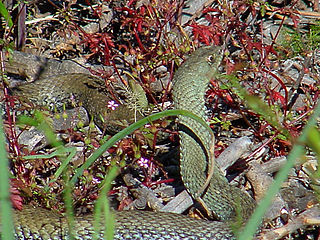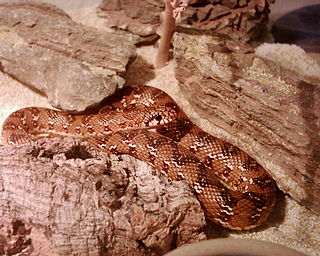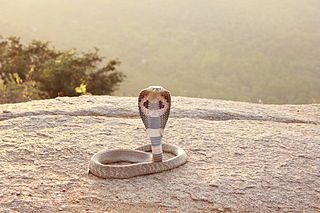
Micrurus is a genus of venomous coral snakes of the family Elapidae.

Leptodeira is a genus of colubrid snakes commonly referred to as cat-eyed snakes. The genus consists of 17 species that are native to primarily Mexico and Central America, but range as far north as the Rio Grande Valley region of Texas in United States and as far south as Argentina in South America.

Sibynophis is a genus of nonvenomous colubrid snakes, commonly called many-toothed snakes, which together with Scaphiodontophis make up the subfamily Sibynophiinae.

Erythrolamprus is a genus of colubrid snakes, commonly known as false coral snakes, native to Central America, the Caribbean, and the northern part of South America. They appear to be coral snake mimics.
Erythrolamprus ornatus, also known commonly as the ornate ground snake and the Saint Lucia racer, is a species of snake in the family Colubridae. The species is native to the eastern Caribbean. It is the rarest snake on earth with fewer than 20 left in the wild.

Psammophiidae is a family of elapoid snakes. They were formerly placed as a subfamily of the Lamprophiidae, but have been more recently identified as a distinct family.
The Estado Falcón worm snake is a species of snake in the family Typhlopidae. The species is endemic to Venezuela.

Pseudalsophis is a genus of snakes in the family Colubridae. The genus is endemic to South America.

The Lamprophiidae are a family of snakes found throughout much of Africa, including the Seychelles. There are 89 species as of July 2022.

Colubroidea is a superfamily of snakes in the clade Colubroides that includes Colubridae, with some studies splitting Colubridae into multiple families that make up Colubroidea. Historically, Colubroidea also included other caenophidian snakes such as cobras and vipers, as these snakes form a clade. However these groups are now divided into several distinct, but related, families. Zaher et al. (2009) proposed to redefine Colubroidea for colubrids and related families, while designating Colubroides as the group containing vipers and cobras as well as colubroids. The ReptileDatabase considers Colubroidea to be composed of Colubridae and the members of its sister group, Elapoidea, and does not recognize the division of Colubridae into multiple families.

Dipsadinae is a large subfamily of colubroid snakes, sometimes referred to as a family (Dipsadidae). They are found in most of the Americas, including the West Indies, and are most diverse in South America. There are more than 700 species.

Prosymna is a genus of elapoid snake. It is the only genus in the family Prosymnidae. They were formerly placed as a subfamily of the Lamprophiidae, but have been more recently identified as a distinct family.
Mussurana is a genus of snakes in the family Colubridae. The genus is endemic to South America.

Lygophis is a genus of snakes in the subfamily Dipsadinae of the family Colubridae. The genus is endemic to Panama and South America.

Pseudaspididae is a small family of elapoid snakes. They were formerly placed as a subfamily of the Lamprophiidae, but have been more recently identified as a distinct family.
Caaeteboia is a genus of snakes in the subfamily Dipsadinae of the family Colubridae. The genus is endemic to Brazil.
Rodriguesophis is a genus of snakes in the family Colubridae. The genus contains three species, all of which are endemic to Brazil.

The Colubroides are a clade in the suborder Serpentes (snakes). It contains over 85% of all the extant species of snakes. The largest family is Colubridae, but it also includes at least six other families, at least four of which were once classified as "Colubridae" before molecular phylogenetics helped in understanding their relationships. It has been found to be monophyletic.

The Elapoidea are a superfamily of snakes in the clade Colubroides, traditionally comprising the families Lamprophiidae and Elapidae. Advanced genomic sequence studies, however, have found lamprophiids to be paraphyletic in respect to elapids. In describing the subfamily Cyclocorinae, Weinell et al. (2017) suggested some or all subfamilies of Lamprophiidae should be reevaluated at full family status as a way to prevent the alternative, which is classifying them as elapids. This was followed in later studies such as Zaher et al. (2019).
Pseudalsophis thomasi, or Thompson's racer, a species of snake in the family Colubridae. It is endemic to several islands in the Galápagos group.














